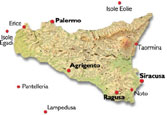 |
 |
|
Motya (TP) | ||
|
||||||||
|
To visit the island you park your car opposite and hire a boat. The original, taciturn, boatman (who appears in all guide books over the last 20 years) is called Michele Pace, and in 1993 had two beautiful dogs to keep him company. My two fellow passengers were fungi-collectors (for the kitchen, not scientific research!) such as I found at most sites that autumn - equipped with large plastic bags and a sharp knife. The car park is expensive - the ferry-crossing barely more than the obol you'd pay to Charon. The custodian than was an old bow-legged and be-gaitered retainer straight out of The Leopard; the whole place has a charming run-down genteel atmosphere. There are impressive ruins to be found on a stroll round the island (it'll take about an hour) - including a house with pebble mosaics; the Cothon - a small rectangular harbour; the ruins of the Tophet where child- sacrifice originally took place, and a large palace-like structure on the western shore.
"Male (1.9m), standing, long, clinging diaphanous robe to bottom of ankle (feet missing). Right arm missing beyond axilla; left arm ditto, but the fingers are on the left hip with thumb to the rear. The dress is sleeveless, but very full, ending in a line of selvage which falls straight over the inside of the right thigh. The dress is secured around the chest by a bandeau (with missing pin). It ruckles above the bandeau in front and at the back, folds over itself on the right. It also ruckles over the small of the back, and is stretched tightly over the buttocks, between the legs and over the calves. It ends just above the ankle. The bulge of his genitals is visible in front breaking the folds. The head has three rows of tight curls a lumachella, and is inclined slightly to the left. The weight is on the left leg; the right knee breaks the folds. Eyes are almond-shaped, and deep set in the squarish face. The nose and chin are damaged. The mouth with its very full lips looks strangely un-Greek. The top of the head is roughly finished; two bronze studs show that headgear of some kind was worn." There's (some) agreement that he's Greek, from around 440 BC - but clothed males are rare: was he a charioteer like the one at Delphi? Or a Punic magistrate? Or a god - Heracles or Melkart?
|
 |
Use the table below to find your way around Sicily: |  |
||||||||||
| Map | Index | PA | ME | CT | EN | CL | SR | RG | AG | TP | ||
Printer friendly page: click to print
| What's new? | Search the site? | Main Index? | Bookshop? | Top of Page? | ||||
|
The Classics Pages are written and designed
by Comments, questions and contributions welcome. |
||||||||